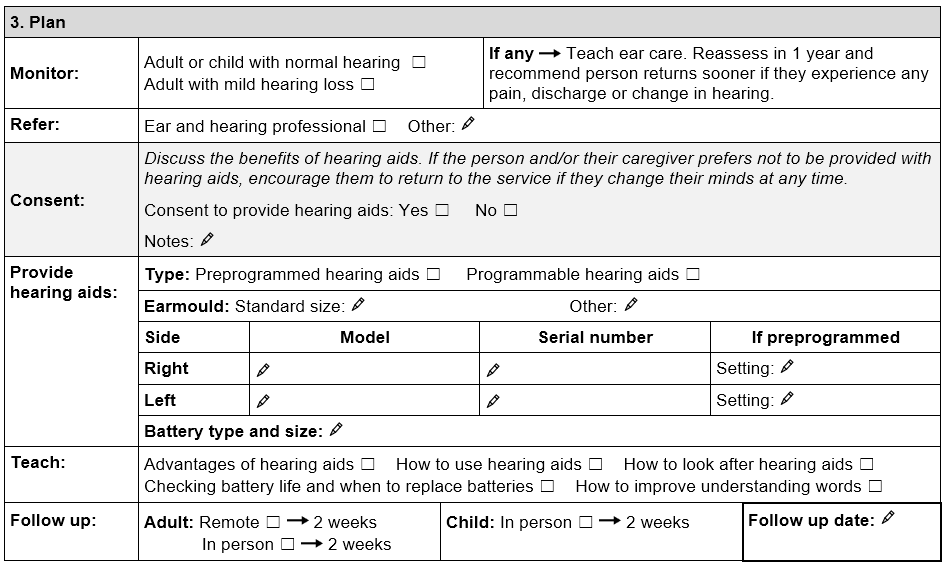After the assessment interview, make a plan with the child and their caregiver. The plan might include:
- Monitoring hearing
- Making a referral
- Providing hearing aids
- Teaching the child and their caregiver how to use hearing aids safely
- Making a follow up appointment.

Monitor hearing
You should monitor children within normal hearing range and plan follow up in one year to retest hearing.
Encourage the child and caregiver to return sooner if there is a change in hearing.
Remember Anju?

Anju’s hearing test result was within normal hearing range in both ears.
The health worker explains there are some easy things that will help keep Anju’s ears healthy including:
- Avoid putting anything inside ears
- Avoid swimming in dirty water
- Use earplugs in noisy environments.
The health worker asks Anju and her parents to return in one year for a repeat hearing test to monitor Anju’s hearing. They explain to come back sooner if Anju experiences ear pain, discharge or change in hearing.
Refer
Some children require more specialist assessment by an ear and hearing professional.
Do not provide hearing aids for:
- Children with severe to profound hearing loss
- Children with asymmetrical hearing loss – more than 15 dB difference between right and left ear.
With caregiver permission refer to an ear and hearing professional.
If you are not confident about the test result, discuss with your mentor and refer to an ear and hearing professional.
Question
Read the following case studies.
1. Beth is 13 years old. The average hearing threshold for her right ear is 67 dB. The average hearing threshold in her left ear is 69 dB.
Check the Grade of hearing loss table.
| Grade | Average | Recommendation |
| Within normal range | Average of less than 20 dB | Adults and children: Hearing aids not needed. Teach ear care. Reassess in 1 year or sooner if person or caregiver notices change in hearing or ear health. |
| Mild hearing loss | Average of 20-34 dB | Children: Hearing aid fitting. Adults: Monitor and reassess in 1 year. Teach ear care. |
| Moderate hearing loss | Average of 35-49 dB | Adults and children: Hearing aid fitting. |
| Moderately severe hearing loss | Average of 50-64 dB | Adults and children: Hearing aid fitting. |
| Severe hearing loss | Average of 65-79 dB | Children: Refer to ear and hearing professional. Adults: Hearing aid fitting. |
| Profound hearing loss | Average of more than 80 dB | Adults and children: Refer to ear and hearing professional |
What would you do next?
Select one.
Refer is correct!
Beth has severe hearing loss. With her caregivers permission, she should be referred to an ear and hearing professional for a more specialist assessment.
2. Jampa is 11 years old. The average hearing threshold for his right ear is 23 dB. The average hearing threshold in his left ear is 55 dB.
What would you do next?
Select one.
Refer is correct!
Jampa has more than 15 dB difference between his right and left ears. With his caregivers permission, he should be referred to an ear and hearing professional for a more specialist assessment.
Consent
Some children will benefit from hearing aids.
Explain the potential benefits of hearing aids and offer the opportunity for the child to experience using hearing aids before deciding.
If the child or their caregiver prefer not to be provided with hearing aids, encourage them to return to the service if they change their mind at any time.
Record if the child and caregiver give consent to provide hearing aids.
Provide hearing aids
First select the type of programmable hearing aid from the available options.
Record details on the form including:
- Hearing aid
- Earmould
- Battery.
Tip
Check packaging and user manual for serial numbers. A programmable hearing aid serial number may be recorded in the programming software when the hearing aid is connected.
Teach how to use
For a child to get the most benefit from hearing aids, it is important to explain to both the child and their caregiver:
- Advantages of hearing aids
- How to use and look after hearing aids
- How to check battery life and when to replace batteries
- How to improve understanding of words.
Instruction
Learn more in Lesson four on how to use hearing aids.
Follow up
Children need time to adjust to using hearing aids. Advice on simple problem solving can help.
It is important to follow up in person with the child and their caregiver within two weeks to check how they are getting on.
Instruction
Learn more in Lesson five about hearing aid follow up.
Instruction
Test your knowledge by making a plan for Basir.
Question

Remember Basir?
Basir is six years old and goes to school with his five-year-old sister, Siti. After a school screening Basir was referred for a hearing test. Basir was identified with hearing loss. The results show Basir has an average hearing threshold of 53.75 dB in his right ear and 56.25 dB in his left ear.
Check the Grade of hearing loss table.
| Grade | Average | Recommendation |
| Within normal range | Average of less than 20 dB | Adults and children: Hearing aids not needed. Teach ear care. Reassess in 1 year or sooner if person or caregiver notices change in hearing or ear health. |
| Mild hearing loss | Average of 20-34 dB | Children: Hearing aid fitting. Adults: Monitor and reassess in 1 year. Teach ear care. |
| Moderate hearing loss | Average of 35-49 dB | Adults and children: Hearing aid fitting. |
| Moderately severe hearing loss | Average of 50-64 dB | Adults and children: Hearing aid fitting. |
| Severe hearing loss | Average of 65-79 dB | Children: Refer to ear and hearing professional. Adults: Hearing aid fitting. |
| Profound hearing loss | Average of more than 80 dB | Adults and children: Refer to ear and hearing professional. |
What action would you recommend for Basir?
Select one.
Provide hearing aids is correct!
Basir has moderately severe hearing loss in both ears. Continue to hearing aid fitting is recommended.